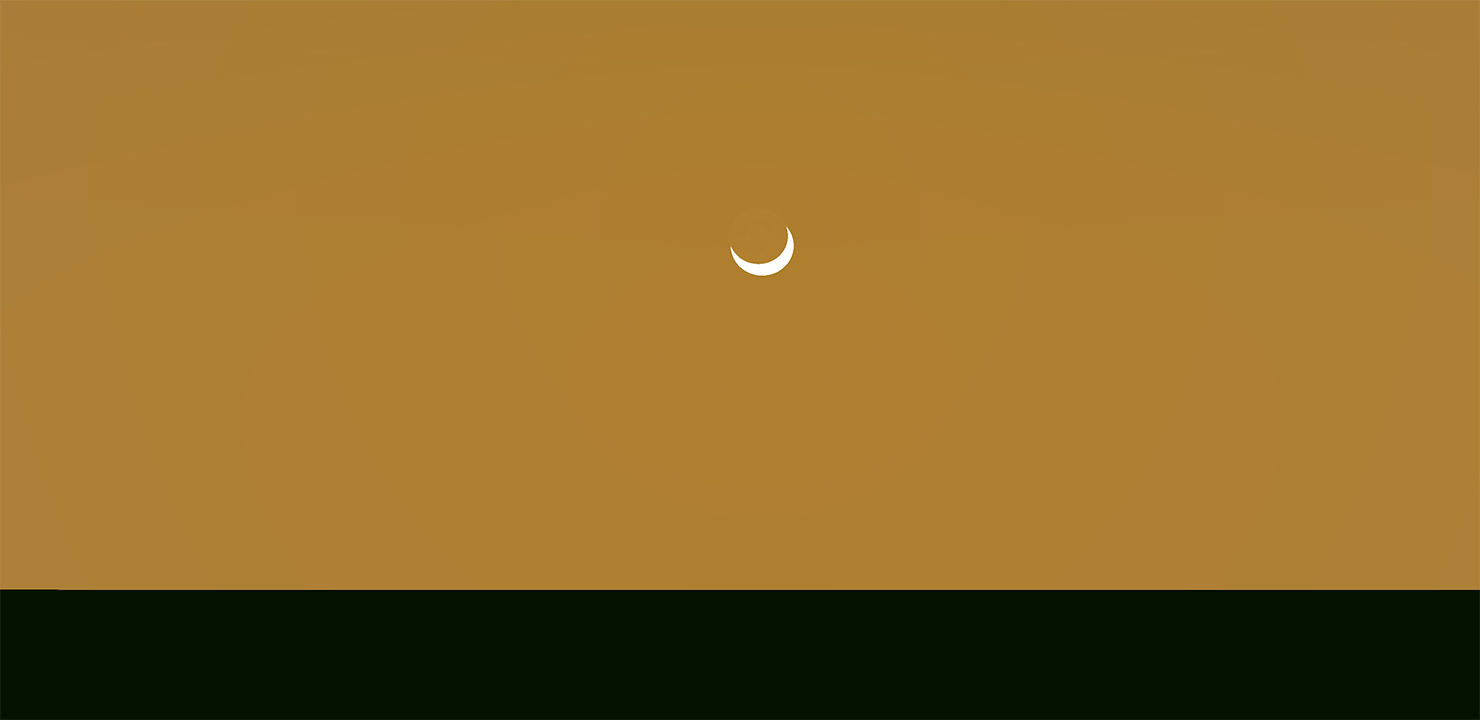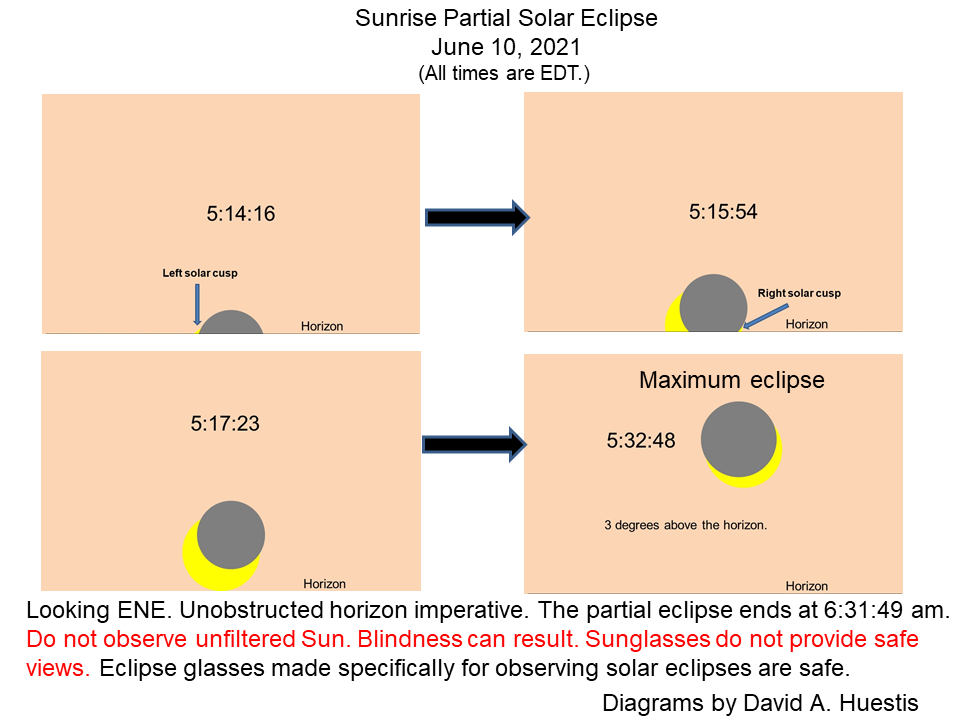
Sunrise Partial Solar Eclipse
June 2021 :
Note: This article may contain outdated information
This article was published in the June 2021 issue of The Skyscraper and likely contains some information that was pertinent only for that month. It is being provided here for historical reference only.
Who can forget the amazing partial solar eclipse spectacle seen locally on August 21, 2017, as part of the Great American Total Solar Eclipse experience across the United States? Here in Rhode Island 65% of the solar disk was covered by the Moon during maximum. My wife Tina and I had travelled to Adams, Tennessee, and witnessed totality for two minutes and thirty-six seconds. You can read about our entire experience by clicking on this website: The Journey to Totality (theskyscrapers.org).
This year on June 10 there will be an annular solar eclipse that will be seen along a path in Canada, Greenland and Siberia (https://skyandtelescope.org/wp-content/uploads/Annular-solar-eclipse-path-June-10-2021.jpg). Briefly described, an annular eclipse occurs when the Earth, Moon and Sun are in alignment, but the Moon’s elliptical orbit has caused it to be a little farther from the Earth so that it doesn’t completely obscure the Sun. We then see a ring (annulus) of the Sun’s photosphere and chromosphere surrounding the Moon. As with a total eclipse, observers outside the path will only see a partial eclipse.
Though we are far from the path of annularity, we will still experience a partial solar eclipse. The circumstances are unique for us. The Sun will rise above the eastern horizon already in eclipse. All of the times provided (a.m./morning) below are calculated for Providence and reflect EDT (Eastern Daylight Time).
For this event you will only see the Moon where it obscures the solar disk. If you could see the Moon’s limb (edge), it breaks the horizon at 5:13:05. The first cusp of the bright solar disk rises (the left hand portion) around 5:14:16. Then the bright cusp of sunlight on the right hand side will rise above the horizon at 5:15:54. The Sun will rise from left to right as it ascends the sky. An observer will only see the portion of the Moon that encroaches upon the Sun and sweeps across it. The solar disk will completely clear the horizon at 5:17:23. At that time 53% of the solar surface will already be covered by the Moon. As the Sun and Moon continue to rise, more and more of the solar disk will be covered by the Moon. Mid or maximum eclipse occurs at 5:32:48 when 72% of the solar surface will be obscured. The maximum obscuration occurs with the Sun and Moon just over three degrees above the horizon. After that time the Moon will begin to uncover the Sun and the eclipse will end at 6:31:49. At that time the pair will be 13 degrees high. From start to finish for us in Rhode Island the duration of this eclipse will be approximately one hour and 17 minutes.

See the accompanying diagram for how the eclipse will appear at specific times. Also, check out the following website for an animation of how this partial solar eclipse will look from start to finish in the Providence area: https://www.timeanddate.com/eclipse/in/usa/providence?iso=20210610.
For the 2017 partial solar eclipse, as long as you had solar eclipse glasses or specially filtered telescopes, the eclipse was easy to observe because it was high in the sky. However, there will be a few challenges for observing this event locally. First, you’ll require an unobstructed view of the east-northeast horizon. Second, and most importantly, please be very cautious. I know we all watch sunrises and sunsets through the Earth’s dense atmosphere just above our local horizon, but do not be tempted to stare at the partial eclipse for any length of time. Despite a large portion of the Sun being covered by the Moon, harmful visible and invisible radiation will cause irreparable eye damage. Refrain from monitoring this event without proper filters or alternative observing methods.
Sunglasses will not provide adequate protection from the Sun’s harmful rays. Number 14 welder’s glass is safe to use. DO NOT use exposed film, if you are old enough to know what it is, of any kind. This method is not safe. In past columns on observing solar eclipses I have instructed folks on how to build a solar eclipse viewer using a shoe box. I’m not sure this observing method will efficiently work for this eclipse. With the Sun so low, the resulting image may not be bright enough to project a reasonable image.
Only if you are an experienced solar observer should you attempt to observe this partial eclipse with a properly filtered telescope or by using the solar projection method. If you have never observed the Sun before this event, don’t start now! Don’t risk your eyesight due to an oversight or an outright mistake. Even if you have one of those department store refractors that often come with small glass or plastic filters, do not be tempted to use them. They have been known to shatter when exposed to the Sun’s concentrated image.
By far the simplest observing method will be to use those solar eclipse glasses. So if you haven’t heeded my earlier advice in prior columns to locate yours from August 2017, you still have some time to do so.
Keep your eyes to the skies, but please remember to keep them protected if you intend on viewing the partial solar eclipse of June 10.
And lastly, after four plus decades of enlightening southern New Englanders about astronomical events, this is my final column. There have been many news editors and meteorologists who have facilitated my mission to encourage folks to look to the skies. I would like to publicly thank them all, but I fear I would inadvertently forget to include an important name or two. By including my entire column or elements thereof as part of their news outlet duties, they have all contributed to the education of many of our fellow citizens.
However, there are two individuals who deserve recognition for helping to improve my columns. First up is Jim Hendrickson. Jim is Skyscrapers’ newsletter editor and web master. Over several decades Jim has provided countless star maps and other graphics to accompany my columns. The old adage, “a picture is worth a thousand words,” should be doubled when referring to Jim’s contributions. Thanks Jim.
And last, but certainly not least, a big thank you to my wife Tina. She has been my editor for 30 plus years. Her corrections and suggestions have earned her the nickname “Red Pen” Tina. Tina’s recommendations have always improved the finished product. Only a couple of times did some grammatical error get by both of us. And seldom have I seen an editor make any significant changes to my columns prior to going to print.
Thank you readers. I trust that over the years you found the time to watch a meteor shower, observe a lunar eclipse, or simply just gaze at the heavens and contemplate our place in our vast universe.
Please consider visiting the local observatories once their Covid-19 protocols have been lifted.
Be well.
A partial eclipse visible at sunrise, June 10. Maximum eclipse in Rhode Island will be at 5:32am when 72.5% of the Sun will be obscured by the Moon.



